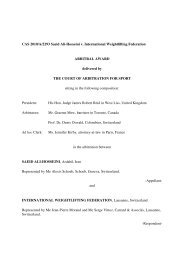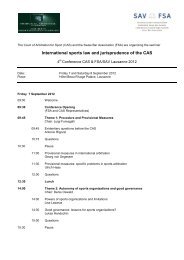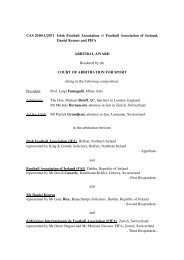(CAS) Bulletin - Tribunal Arbitral du Sport / TAS
(CAS) Bulletin - Tribunal Arbitral du Sport / TAS
(CAS) Bulletin - Tribunal Arbitral du Sport / TAS
Create successful ePaper yourself
Turn your PDF publications into a flip-book with our unique Google optimized e-Paper software.
in those countries is rampant. Since the level of<br />
clenbuterol testing in Spain is so low, it is not only<br />
plausible, but it is likely that dishonest farmers who<br />
wish to improve the size and leanness of their animal<br />
would resort to using clenbuterol, which is also<br />
mentioned by Dr Tomás Martín-Jiménez in his expert<br />
report. According to Mr Contador, the Castellana<br />
Detectives’ report also proves that clenbuterol can be<br />
easily purchased on the Internet, without the need for<br />
offi cial documents.<br />
Therefore, Mr Contador concludes that it cannot<br />
be disputed that there exists, to this day, an illicit<br />
practice of clenbuterol use in stockbreeding countries<br />
around the world and that humans are exposed to the<br />
risk that they might consume meat from an animal<br />
treated with clenbuterol. The Appellants’ argument<br />
that farmers are not using clenbuterol because it is<br />
banned in Spain is not grounded in reality.<br />
Findings of the Panel<br />
The Panel took note of the fact that the sanctions<br />
imposed on farmers using clenbuterol or other<br />
beta-agonists to fatten their cattle became much<br />
more severe after the implementation in Spain<br />
of the mandatory EU Regulations but fi nds that<br />
the existence of more severe sanctions today does<br />
not, in itself, disqualify the meat contamination<br />
theory. That said, the Panel fi nds that the statistics<br />
regarding the use of clenbuterol or beta-agonists in<br />
general corroborate the allegation of the Appellants<br />
that after the implementation of these Regulations,<br />
the illicit practise of illegally fattening cattle using<br />
clenbuterol became very rare in Spain. This fact is also<br />
corroborated by the fi gures and statistics contained<br />
in the report of Castellana Detectives submitted by<br />
Mr Contador and by the testimony of Mr Martin of<br />
Castellana Detectives who testifi ed at the hearing.<br />
4.2.3 As to the statistics<br />
Submissions by the Parties<br />
WADA submitted that, based on the amount of<br />
clenbuterol present in the bodily sample of the<br />
Athlete, the meat consumed would have had to have<br />
been contaminated to a level signifi cantly in excess<br />
of the minimum detection levels in the EU within<br />
the context of the National Resi<strong>du</strong>e Monitoring<br />
Plan (“ NRMP ”), most probably around ten times<br />
the maximum permitted resi<strong>du</strong>e limit under EC<br />
Regulation EC 2391-2000. The estimation of the level<br />
of contamination of the meat is in the range of 1 ug/<br />
Kg according to the expert report of Dr Rabin. From<br />
this report it can also be derived that these levels of<br />
contamination mean that the relevant animal would<br />
have been slaughtered immediately or shortly after the<br />
administration of the last dose of clenbuterol. This<br />
is a pre-requisite to the meat contamination theory<br />
advanced by the Athlete which makes little sense in<br />
the eyes of WADA. On the one hand, the animal<br />
would not “benefi t” from the substance to the fullest<br />
extent and on the other hand, it increases the risk for<br />
the farmer of being caught through the routine and<br />
random evaluations and inspections carried out at the<br />
slaughterhouse.<br />
According to WADA, the Commission Staff Working<br />
Document on the Implementation of National Resi<strong>du</strong>e<br />
Monitoring Plans in the Member States in 2008 (the “EU<br />
2008 Report ”) is concrete evidence of the extreme<br />
rarity of the use of clenbuterol in livestock farming<br />
in Europe. Nearly three hundred thousand tests<br />
con<strong>du</strong>cted on animals in 2008 across the Member<br />
States have not resulted in a single confi rmed case of<br />
clenbuterol.<br />
The EU 2008 Report provides even more detailed<br />
fi gures with respect to tests specifi cally carried<br />
out on bovines for the purpose of detecting betaagonists.<br />
23,966 targeted and suspect samples were<br />
con<strong>du</strong>cted on bovines for beta-agonists in 2008<br />
and not a single non-compliant sample involving<br />
clenbuterol has been fi nally confi rmed; one case in<br />
Italy remains under investigation. Indeed, out of the<br />
41,740 samples across all relevant animal types which<br />
were specifi cally analysed for beta-agonists, there<br />
were only two non-compliant samples, both in the<br />
Netherlands and neither involving clenbuterol.<br />
WADA further point out that the samples recorded<br />
in the EU 2008 Report fall into two categories:<br />
“ Targeted Samples ” and “Suspect Samples ”. Whereas<br />
the latter category relates to samples taken as a<br />
direct result of previous non-compliant samples or<br />
the suspicion of illegal treatment at any stage of the<br />
food chain (and is therefore, it is submitted, much<br />
more likely to pro<strong>du</strong>ce further non-compliant results<br />
than a random sampling methodology), even the<br />
former category (i.e. Targeted Samples) is aimed at<br />
the categories and types of animals most likely to<br />
pro<strong>du</strong>ce non-compliant results.<br />
Even 1) assuming that all of the samples recorded<br />
in the EU 2008 Report were random and that the<br />
clenbuterol case in Italy was confi rmed (as opposed<br />
to being merely a suspect sample); and 2) taking only<br />
the statistics specifi cally relating to beta-agonists<br />
in bovines, the necessary conclusion is that out of<br />
23,966 samples, only one contained clenbuterol.<br />
Therefore, based on these fi gures, the probability<br />
that a given bovine in Europe would be contaminated<br />
with clenbuterol at a level capable of being detected<br />
Jurisprudence majeure / Leading cases<br />
-<br />
122





